Paper Menu >>
Journal Menu >>
 Intelligent Control and Automation, 2011, 2, 47-56 doi:10.4236/ica.2011.21006 Published Online February 2011 (http://www.SciRP.org/journal/ica) Copyright © 2011 SciRes. ICA Optimal Risk-Sensitive Filtering for System Stochastic of Second and Third Degree Ma Aracelia Alcorta-Garcia, Sonia Gpe Anguiano Rostro, Mauricio Torres Torres Department of Physical and Mathematical Sciences, Autonomous University of Nuevo Leon, Cd. Universitaria, San Nicolas, Mexico E-mail: aalcorta@fcfm.uanl.mx, srostro@hotma il.com, mautor2@gmail.com Received October 9, 2010; revised February 8, 2011; accepted February 10, 2011 Abstract The risk-sensitive filtering design problem with respect to the exponential mean-square cost criterion is con- sidered for stochastic Gaussian systems with polynomial of second and third degree drift terms and intensity parameters multiplying diffusion terms in the state and observations equations. The closed-form optimal fil- tering equations are obtained using quadratic value functions as solutions to the corresponding Focker- Plank-Kolmogorov equation. The performance of the obtained risk-sensitive filtering equations for stochastic polynomial systems of second and third degree is verified in a numerical example against the optimal po- lynomial filtering equations (and extended Kalman-Bucy for system polynomial of second degree), through comparing the exponential mean-square cost criterion values. The simulation results reveal strong advan- tages in favor of the designed risk-sensitive equations for some values of the intensity parameters. Keywords: Optimal Nonlinear Filtering, Risk-Sensitive Filtering, Extended Kalman-Bucy Filtering 1. Introduction Since the linear optimal filter was obtained by Kalman and Bucy (60’s), numerous works are based on it, see for example [1-5], of the variety of all those. The determi- nistic filter model introduced by Mortensen [6] provides an alternative to stochastic filtering theory. In this model, errors in the state dynamics and the observations are modeled as deterministic “disturbance functions”, and an exponential mean-square cost criterion disturbance error is to be minimized. Special conditions are given for the existence, continuity and boundedness of f Xt in the state equation, which is considered nonlinear, and the linear function hXt in the observation equation. A concept of stochastic risk-sensitive estimator, introduced more recently by McEneaney [7], regard a dynamic sys- tem where f Xt is a nonlinear function, linear ob- servations and existence of parameter multiplying the diffusion term in both equations (state and observa- tions). In [8] were obtained the suboptimal risk-sensitive filtering equations for polynomial systems of third de- gree and applied to the pendulum equations [9], in which the original system was linearized applying Taylor series around the equilibrium point. In [10,11] it is regarded f Xt as nonlinear function. This paper presents an application of the equations obtained in [10,11] for sin- gular form of f Xt (polynomial of second and third degree). The goal of this work is to obtain the optimal risk- sensitive filtering equations when the form of f Xt is polynomial of second and third degree and parameter multiplying the diffusion term in the state and obser- vations equations. There filtering equations are obtained taking a value function as solution of the nonlinear pa- rabolic partial differential equation and exponential mean-square exponential cost criterion to be minimized. Undefined parameters in the value function are calcu- lated through ordinary differential equations composed by collecting terms corresponding to each power of the state-dependent polynomial in the nonlinear parabolic PDE equations. This procedure leads to the obtention of the optimal risk-sensitive filtering equations. The closed-form for risk-sensitive filtering equations is explicitly obtained in this work. Although the diffi- culty presented by systems of second and third degree, in this work is shown an advantage for risk-sensitive filter- ing equations versus extended Kalman-Bucy and poly- nomial filtering equations under certain values of the parameter . This performance is shown verified in a numerical example against the mean-square optimal for 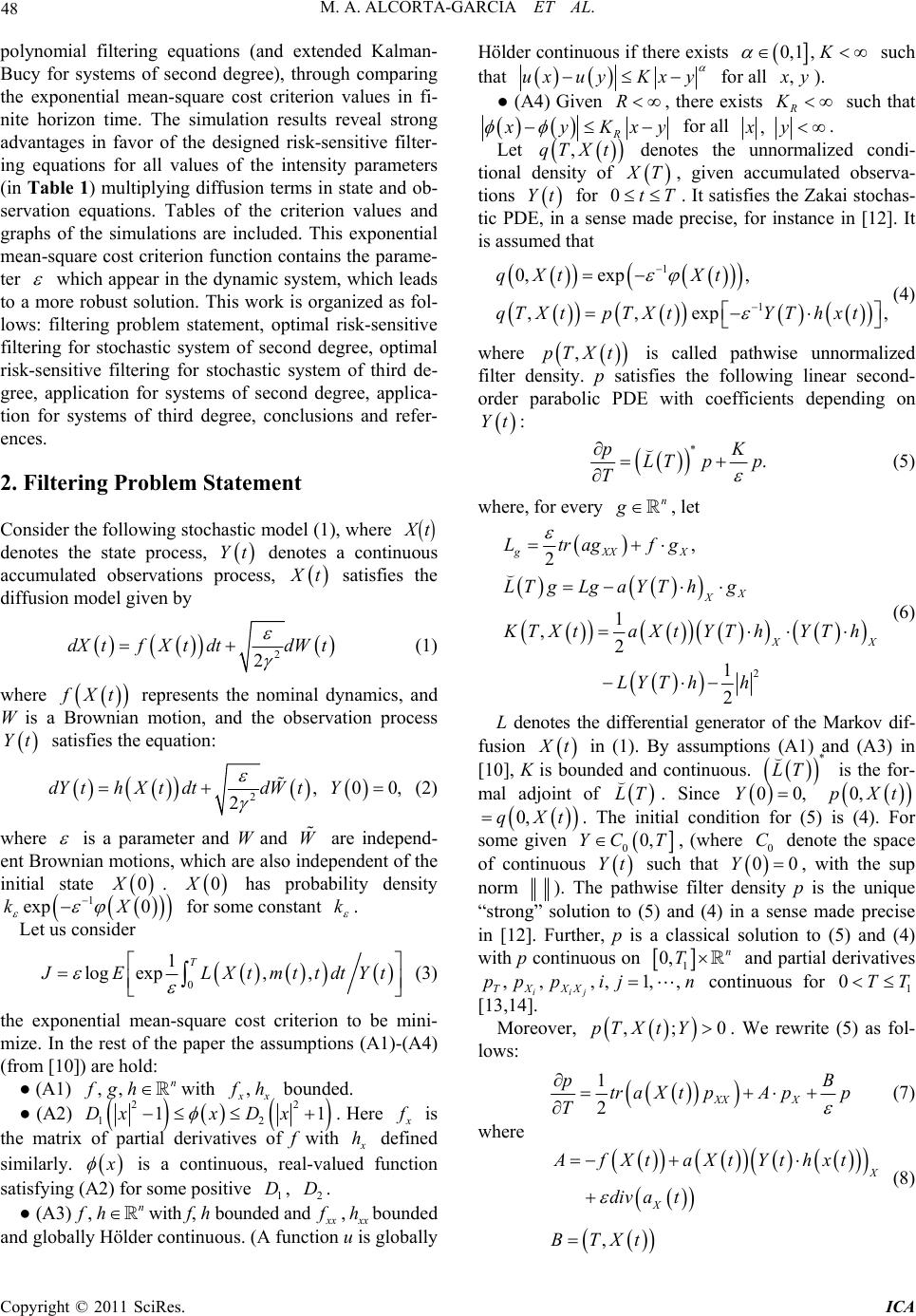 M. A. ALCORTA-GARCIA ET AL. Copyright © 2011 SciRes. ICA 48 polynomial filtering equations (and extended Kalman- Bucy for systems of second degree), through comparing the exponential mean-square cost criterion values in fi- nite horizon time. The simulation results reveal strong advantages in favor of the designed risk-sensitive filter- ing equations for all values of the intensity parameters (in Table 1) multiplying diffusion terms in state and ob- servation equations. Tables of the criterion values and graphs of the simulations are included. This exponential mean-square cost criterion function contains the parame- ter which appear in the dynamic system, which leads to a more robust solution. This work is organized as fol- lows: filtering problem statement, optimal risk-sensitive filtering for stochastic system of second degree, optimal risk-sensitive filtering for stochastic system of third de- gree, application for systems of second degree, applica- tion for systems of third degree, conclusions and refer- ences. 2. Filtering Problem Statement Consider the following stochastic model (1), where X t denotes the state process, Yt denotes a continuous accumulated observations process, X t satisfies the diffusion model given by 2 2 dX tfX tdtdW t (1) where f Xt represents the nominal dynamics, and W is a Brownian motion, and the observation process Yt satisfies the equation: 2, 00, 2 dY th XtdtdW tY (2) where is a parameter and W and W are independ- ent Brownian motions, which are also independent of the initial state 0X. 0X has probability density 1 exp 0kX for some constant k . Let us consider 0 1 log exp,, T J ELXtmttdtYt (3) the exponential mean-square cost criterion to be mini- mize. In the rest of the paper the assumptions (A1)-(A4) (from [10]) are hold: ● (A1) ,,n fghwith , x x fh bounded. ● (A2) 22 12 11Dxx Dx . Here x f is the matrix of partial derivatives of f with x h defined similarly. x is a continuous, real-valued function satisfying (A2) for some positive 1 D, 2 D. ● (A3) ,n fh with f, h bounded and x x f, x x h bounded and globally Hölder continuous. (A function u is globally Hölder continuous if there exists 0,1, K such that uxuyKxy for all , x y). ● (A4) Given R , there exists R K such that R x yKxy for all , xy. Let ,qTX t denotes the unnormalized condi- tional density of X T, given accumulated observa- tions Yt for 0tT . It satisfies the Zakai stochas- tic PDE, in a sense made precise, for instance in [12]. It is assumed that 1 1 0, exp, ,,exp , qXt Xt qTXtpTX tYThxt (4) where ,pTX t is called pathwise unnormalized filter density. p satisfies the following linear second- order parabolic PDE with coefficients depending on Yt: *. pK LT pp T (5) where, for every n g, let 2 , 2 1 ,2 1 2 gXXX X X XX Ltrag fg LT gLgaYThg K TXtaXtYT hYT h LYT hh (6) L denotes the differential generator of the Markov dif- fusion X t in (1). By assumptions (A1) and (A3) in [10], K is bounded and continuous. * LT is the for- mal adjoint of LT . Since 00,Y 0,pXt 0,qXt. The initial condition for (5) is (4). For some given 00,YC T, (where 0 C denote the space of continuous Yt such that 00Y, with the sup norm ). The pathwise filter density p is the unique “strong” solution to (5) and (4) in a sense made precise in [12]. Further, p is a classical solution to (5) and (4) with p continuous on 1 0, n T and partial derivatives ,, ,,1,, iij TX XX pp pijn continuous for 1 0TT [13,14]. Moreover, ,;0pTX tY. We rewrite (5) as fol- lows: 1 2XX X pB tr aXtpApp T (7) where X X AfXtaXtYthxt div at (8) ,BTXt 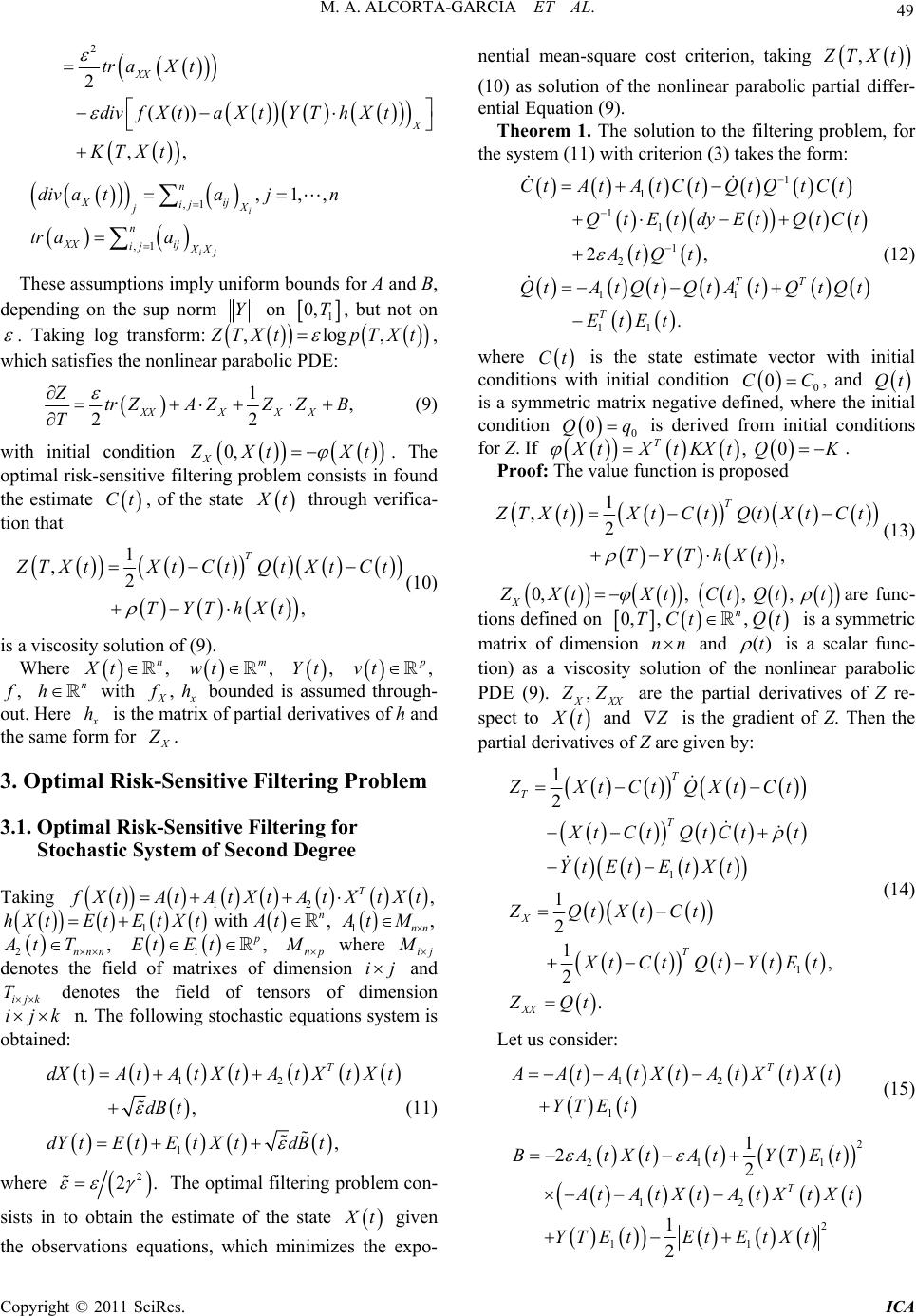 M. A. ALCORTA-GARCIA ET AL. Copyright © 2011 SciRes. ICA 49 2 2 (()) ,, XX X tr aXt divfX taXtYThXt KTXt ,1 ,1 ,1,, i ij n Xij ij X j n XX ij ij XX div atajn tr aa These assumptions imply uniform bounds for A and B, depending on the sup norm Y on 1 0,T, but not on . Taking log transform: ,log, Z TXt pTXt , which satisfies the nonlinear parabolic PDE: 1, 22 XXXX X ZtrZA ZZZB T (9) with initial condition 0, X Z Xt Xt . The optimal risk-sensitive filtering problem consists in found the estimate Ct, of the state X t through verifica- tion that 1 ,2 , T Z TXtXtCtQt XtCt TYThXt (10) is a viscosity solution of (9). Where , n Xt , m wt ,Yt , p vt , f n h with , Xx f h bounded is assumed through- out. Here x h is the matrix of partial derivatives of h and the same form for X Z . 3. Optimal Risk-Sensitive Filtering Problem 3.1. Optimal Risk-Sensitive Filtering for Stochastic System of Second Degree Taking 12 , T f XtAtAtXtAtXtXt 1 hXtEtE tXt with , n At 1, nn At M 2, nnn At T 1, p EtE t np M where ij M denotes the field of matrixes of dimension ij and ijk T denotes the field of tensors of dimension ijk n. The following stochastic equations system is obtained: 12 1 t , , T dXAtAt X tAt Xt X t dB t dYtEtEtXtdB t (11) where 2 2. The optimal filtering problem con- sists in to obtain the estimate of the state X t given the observations equations, which minimizes the expo- nential mean-square cost criterion, taking , Z TXt (10) as solution of the nonlinear parabolic partial differ- ential Equation (9). Theorem 1. The solution to the filtering problem, for the system (11) with criterion (3) takes the form: 1 1 1 1 1 2 11 11 2, . TT T CtAtA tCtQtQtCt QtEtdyEt QtCt AtQ t QtA tQtQtAtQtQt EtEt (12) where Ct is the state estimate vector with initial conditions with initial condition 0 0CC, and Qt is a symmetric matrix negative defined, where the initial condition 0 0Qq is derived from initial conditions for Z. If , 0 T X tXtKXtQ K . Proof: The value function is proposed 1 ,() 2 , T Z TXtXtCtQtXtCt TYThXt (13) 0,, , , X Z XtXtCt Qtt are func- tions defined on 0, ,, n TCt Qt is a symmetric matrix of dimension nn and ()t is a scalar func- tion) as a viscosity solution of the nonlinear parabolic PDE (9). , XXX Z Z are the partial derivatives of Z re- spect to X t and Z is the gradient of Z. Then the partial derivatives of Z are given by: 1 1 1 2 1 2 1 , 2 . T T T X T XX ZXtCtQXtCt XtCtQtCtt YtEtE tXt ZQtXtCt X tCtQtYtEt ZQt (14) Let us consider: 12 1 T A AtAt XtAtXt X t YTE t (15) 2 21 1 12 2 11 1 22 – 1 2 T BAtXtAtYTEt A tAtXtA tXtXt YTEtEtEtXt  M. A. ALCORTA-GARCIA ET AL. Copyright © 2011 SciRes. ICA 50 Substituting (14) and the expressions for A, B in (9); we obtain: 1 12 1 1 11 2 112 1 02 2 11 22 11 22 1 2 1 2 TT T T T T X tCtQtXtCtQtCt tYtEtEtXt trQt AtAtXt AtXtXtYt EtQtXt CtXt Ct QtYtE tQtXtCt XtCtQt YtEtAt YtEtAt AtXtAtX 2 11 1 . 2 t Xt YtEtEtEtXt (16) Collecting the , TTT X tXt XtXtXt and TT X tXtXtXt terms, and replacing X t by Ct; we obtain the matrix equation for Qt . Col- lecting the X t terms, the vectorial equations for Ct are obtained (12). 3.2. Optimal Risk-Sensitive Filtering for Stochastic System of Third Degree Taking 12 T f XtAtAtXtAtXtXt 3, TT A tX tXtX t 1 hXtEtE tXt with , n At 1, nn At M 2, nnn At T 3, nnnn At T , p Et 1np Et M where ij M denotes the field of matrixes of dimension ij, ijk T denotes the field of tensors of dimension ijk and ijkl T denotes the field of tensors of dimension ijkl. The fol- lowing stochastic equations system is obtained: 12 3 10 tA , , ,0 T TT dXt AtXt AtXtXt AtX tXtX tdBt dYtEtEtXtdB tXX (17) where 2 2 . Theorem 2. The solution to the filtering problem, for the system (17) with criterion (3) takes the form: 1 1 1 1 1 , 2 CtAtA tCtQtQtCt QtEtdyEtQtCt (18) 112 22 T T QtAtQtQtAtAtQtCt AtQtCt AtQtCt 3 3 3 3 1 11 T T T T T T T T AtCtC tQt AtCtC tQt AtQtCtCt AtQtCtC t QtQtdivfCYtEt EtEt where Ct is the state estimate vector with initial conditions with initial condition 0 0CC, and Qt is a symmetric matrix negative defined, where the initial condition 0 0Qq is derived from initial conditions for Z. If , 0 T X tXtKXtQ K . Proof: In similar form to Theorem 1. 4. Applications 4.1. Application for Systems of Second-Degree. Optimal Risk-Sensitive Filtering Equations Consider the following dynamical stochastic system as- sociated to a continuous stirred tank reactor in which is a chemical reaction occurs. This reaction is in liquid phase and has isothermal character between multicomponents [15]. 111 1 2 2 2112222 2 1, 2 . 2 a aa X tDXutdWt X tDXXDXdWt (19) where 1 X t represents the unnormalized concentra- tion P o PC of a certain specie P of the reactor, 2 X t represents unnormalized concentration QPo CC of a certain specie Q. The control variable u is defined as the relation between the alimentation molar rate by volumet- ric unit of P, designated by P F N and the nominal con- centration P o C, this is P FPo uN FC , where F is the volumetric flow of alimentation on 31 ms . 11a DkVF , 22aPo DkVCF where V is the volume of reactor in 3 m, 1 k and 2 k are constants of first degree given in 1 s . It can take that 1a D and 2a D are considering by 11 a D and 21 a D . Q is highly sour while P is neuter. Then, the following dynamical stochastic system is ob- tained: 11 1 2 2 2122 2 2 2, 2 . 2 XtXutdWt X tXXXdWt (20) 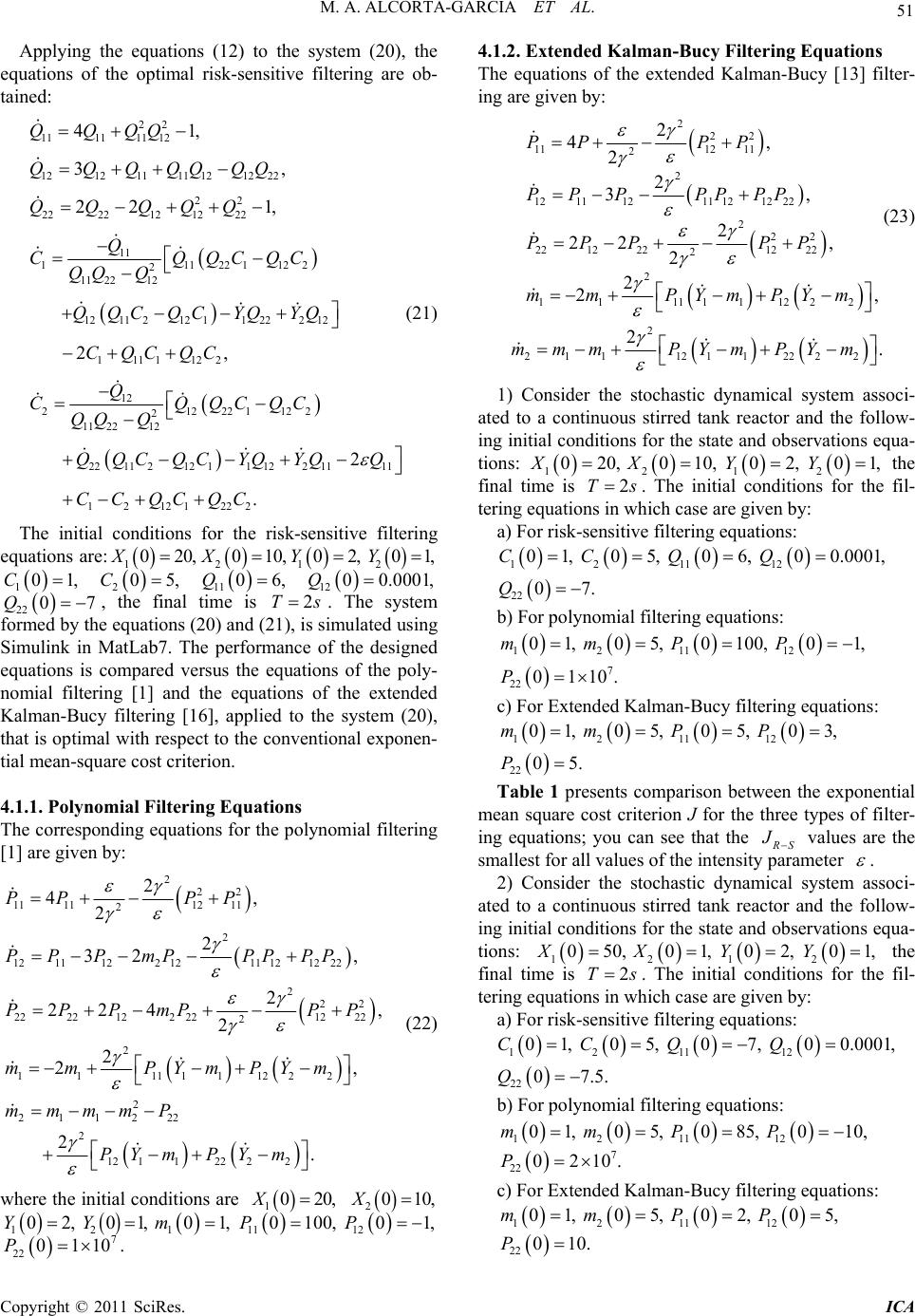 M. A. ALCORTA-GARCIA ET AL. Copyright © 2011 SciRes. ICA 51 Applying the equations (12) to the system (20), the equations of the optimal risk-sensitive filtering are ob- tained: 22 111111 12 12121111 121222 22 222212 1222 11 11122 1122 2 11 2212 1211 212 11 222 12 111 1122 12 2122 2 11 2212 41, 3 22 1, , 2, QQQQ QQQQQQQ QQ QQQ Q CQQCQC QQ Q QQCQCYQYQ CQCQC Q CQQ QQ Q 2 1122 2211 212 11 122 1111 12121222 . 2 CQC QQCQCYQ YQQ CCQCQC (21) The initial conditions for the risk-sensitive filtering equations are: 121 020, 010,02,XXY 201,Y 101,C 205,C 11 06,Q 12 00.0001,Q 22 07Q , the final time is 2Ts. The system formed by the equations (20) and (21), is simulated using Simulink in MatLab7. The performance of the designed equations is compared versus the equations of the poly- nomial filtering [1] and the equations of the extended Kalman-Bucy filtering [16], applied to the system (20), that is optimal with respect to the conventional exponen- tial mean-square cost criterion. 4.1.1. Polyn o mi al Filteri ng E qua ti ons The corresponding equations for the polynomial filtering [1] are given by: 2 22 111112 11 2 2 12111221211 121222 2 22 2222122 221222 2 2 1111 111222 2 211222 2 12 1122 22 2 4, 2 2 32 , 2 224 , 2 2 2, 2 . PP PP PP PmPPPPP PPPmP PP mm PYmPYm mmmm P PY mPYm (22) where the initial conditions are 1020,X 2010,X 102,Y 201,Y 101,m 11 0100,P 12 01,P 7 22 0110P. 4.1.2. Extended Kalman-Bucy Filtering Equations The equations of the extended Kalman-Bucy [13] filter- ing are given by: 2 22 1112 11 2 2 12111211 121222 2 22 22122212 22 2 2 1111 111222 2 4, 2 2 3, 2 22 , 2 2 2, PP PP PP PPPPP PPP PP mm PYmPYm (23) 2 21112112222 2.mmmPYmPYm 1) Consider the stochastic dynamical system associ- ated to a continuous stirred tank reactor and the follow- ing initial conditions for the state and observations equa- tions: 1212 020, 010, 02, 01,XXYY the final time is 2Ts . The initial conditions for the fil- tering equations in which case are given by: a) For risk-sensitive filtering equations: 1 21112 22 01, 05, 06, 00.0001, 07. CC QQ Q b) For polynomial filtering equations: 12 1112 7 22 01, 05, 0100, 01, 0110. mm PP P c) For Extended Kalman-Bucy filtering equations: 1211 12 22 01, 05, 05, 03, 05. mm PP P Table 1 presents comparison between the exponential mean square cost criterion J for the three types of filter- ing equations; you can see that the R S J values are the smallest for all values of the intensity parameter . 2) Consider the stochastic dynamical system associ- ated to a continuous stirred tank reactor and the follow- ing initial conditions for the state and observations equa- tions: 1212 050, 01, 02, 01,XXYY the final time is 2Ts . The initial conditions for the fil- tering equations in which case are given by: a) For risk-sensitive filtering equations: 1 21112 22 01, 05, 07, 00.0001, 07.5. CC QQ Q b) For polynomial filtering equations: 12 1112 7 22 01, 05, 085, 010 . , 0210 mm PP P c) For Extended Kalman-Bucy filtering equations: 12 1112 22 01, 05, 02, 05, 0 10. mm PP P  M. A. ALCORTA-GARCIA ET AL. Copyright © 2011 SciRes. ICA 52 Table 2 presents comparison between the exponential mean square cost criterion J for the three types of filter- ing equations; you can see that the R S J values are the smallest for all values of the intensity parameter . 3) Consider the stochastic dynamical system associ- ated to a continuous stirred tank reactor and the follow- ing initial conditions for the state and observations equa- tions: 1212 00.05, 050, 02, 01,XXYY the final time is 2Ts. The initial conditions for the filtering equations in which case are given by: a) For risk-sensitive filtering equations: 1 21112 22 01, 05, 06, 00.0001, 07. CC QQ Q b) For polynomial filtering equations: 12 1112 7 22 01, 05, 0100, 05, 0110. mm PP P c) For Extended Kalman-Bucy filtering equations: 12 1112 22 01, 05, 01.85, 03, 05. mm PP P Table 3 presents comparison between the exponential mean square cost criterion J for the three types of filter- ing equations; you can see that the R S J values are the smallest for all values of the intensity parameter . With these tables, showed that the filter risk-sensitive is the best, because the values obtained are lower. The Figures 1, 2 and 3 show the 1 Error and 2 Error which are defined as 11 1 ErrorXtC t (in same form for 2 Error); and the exponential mean-square cost criterion values in 2Ts. Table 1. Comparison of exponential mean-square cost cri- terion values J(3) in T = 2s for risk-sensitive, polynomial and extended Kalman-Bucy filteri ng equations . R S J P ol J K B J 0.1 53.4293 69.2292 (t = 0.17s) 69.0816(t = 0.14s) 1 53.5165 145.7323 277.3136 10 53.7994 157.2172 235.5110 100 54.7621 858.7622 189.6937 1000 58.5054 58230 185.7343 Table 2. Comparison of exponential mean-square cost cri- terion values J(3) in T = 2s for risk-sensitive, polynomial and extended Kalman-Bucy filteri ng equations . R S J P ol J K B J 1 505.8493 705.1152 (t = 1.64s) 686.3813 (t = 0.28s) 10 513.3591 712.2522 527.0787 100 537.8120 1430.4728 587.0328 1000 622.1946 59067 641.1202 10000 960.423 5597700 673.6555 Table 3. Comparison of exponential mean-square cost cri- terion values J(3) in T = 2s for risk-sensitive, polynomial and extended Kalman-Bucy filteri ng equations . R S J P ol J K B J 0.1 42.0377 55.6339 70.3916 (t = 0.36s) 1 41.9340 56.1153 144.2845 10 41.6143 70.7942 317.9369 100 40.6851 763.7829 678.2942 1000 38.5611 57957 812.9141 10000 36.1603 55918000 859.8006 Error 1 Error 2 Criterion R-S 0 0.5 1 1.5 2 time 20 15 10 5 0 0 0.5 1 1.5 2 time 0 0.5 1 1.5 2 time 0 5 – 5 60 40 20 0 Figure 1. Graphs of the 1 E rror , 2 E rror , and exponential mean square cost criterion corresponding to the risk-sensi- tive optimal filtering equations for a continuous stirred tank reactor for 10, , 1020X , 2010X 102,Y 201Y . 4.2. Application for Polynomial System of Third Degree 4.2.1. Optimal Risk-Sensitive Filtering Equations The risk-sensitive control equations for third degree po- lynomial systems will be applied to the problem of ori- entation of a monoaxial satellite [15]. The description is as follows: a satellite rotates around a fixed axis without gravity. The rotation torques is produced by a system of mini-engines through a controlled explosion of gases in the opposite direction. The state equations for this model are given by: 2 1121 2 0.5 12 X tXtXtdWt 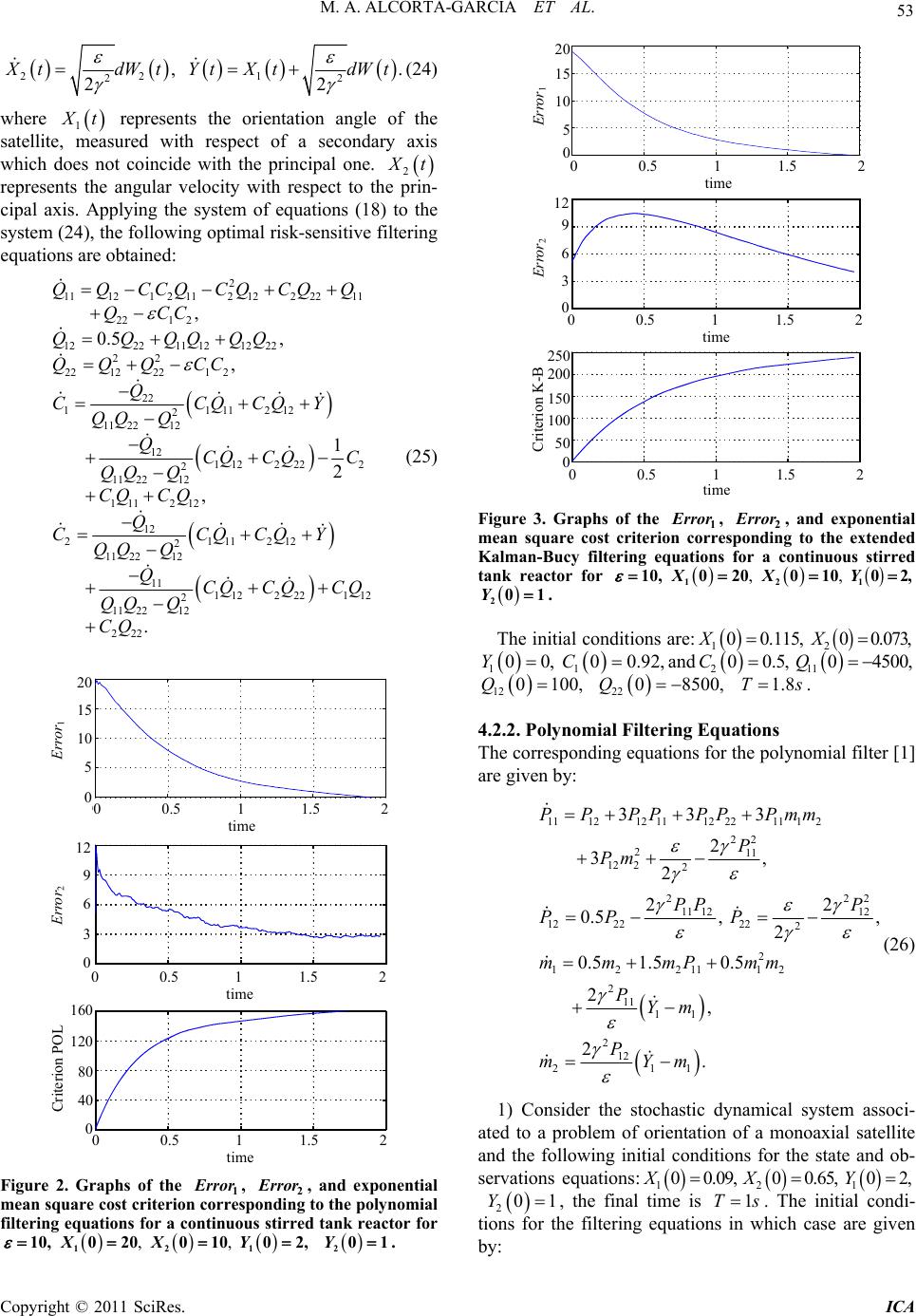 M. A. ALCORTA-GARCIA ET AL. Copyright © 2011 SciRes. ICA 53 221 22 , . 22 X tdWtYtXtdWt (24) where 1 X t represents the orientation angle of the satellite, measured with respect of a secondary axis which does not coincide with the principal one. 2 X t represents the angular velocity with respect to the prin- cipal axis. Applying the system of equations (18) to the system (24), the following optimal risk-sensitive filtering equations are obtained: 2 11121 2 1121222211 221 2 122211121222 22 2212221 2 22 1111212 2 11 2212 12 1122 222 2 11 2212 111212 2 , 0.5 , , 1 2 , QQCCQCQCQQ QCC QQQQQQ QQQCC Q CCQCQY QQ Q QCQCQC QQQ CQ CQ C 12 111212 2 11 2212 11 1122 22112 2 11 2212 222 . QCQ CQY QQ Q QCQ CQCQ QQQ CQ (25) Error 1 Error 2 Criterion POL 0 0.5 1 1.5 2 time 20 12 160 15 10 5 0 9 6 3 0 0 0.5 1 1.5 2 time 0 0.5 1 1.5 2 time 120 80 40 0 Figure 2. Graphs of the 1 E rror , 2 E rror , and exponential mean square cost criteri on corresponding to the poly nomial filtering equations for a continuous stirred tank reactor for 10, , 1020X , 2010X 102,Y 201Y . Error 1 Error 2 Criterion K-B 0 0.5 1 1.5 2 time 20 12 250 0 0.5 1 1.5 2 time 15 10 5 0 9 6 3 0 200 150 100 50 00 0.5 1 1.5 2 time Figure 3. Graphs of the 1 E rror , 2 E rror , and exponential mean square cost criterion corresponding to the extended Kalman-Bucy filtering equations for a continuous stirred tank reactor for 10, , 1020X , 2010X 102,Y 201Y . The initial conditions are: 10 0.115,X 20 0.073,X 100,Y 100.92,C and 200.5,C 11 0 4500,Q 12 0100,Q 22 08500,Q 1.8Ts. 4.2.2. Polyn o mi al Filteri ng E qua ti ons The corresponding equations for the polynomial filter [1] are given by: 1112 121112221112 22 211 12 22 222 11 1212 122222 2 2 1221112 2 11 11 2 12 211 333 2 3, 2 22 0.5, , 2 0.5 1.5 0.5 2, 2. PPPP PPPmm P Pm PP P PP P mmmPmm PYm P mYm (26) 1) Consider the stochastic dynamical system associ- ated to a problem of orientation of a monoaxial satellite and the following initial conditions for the state and ob- servations equations: 12 00.09, 00.65,XX 102,Y 201Y , the final time is 1Ts. The initial condi- tions for the filtering equations in which case are given by: 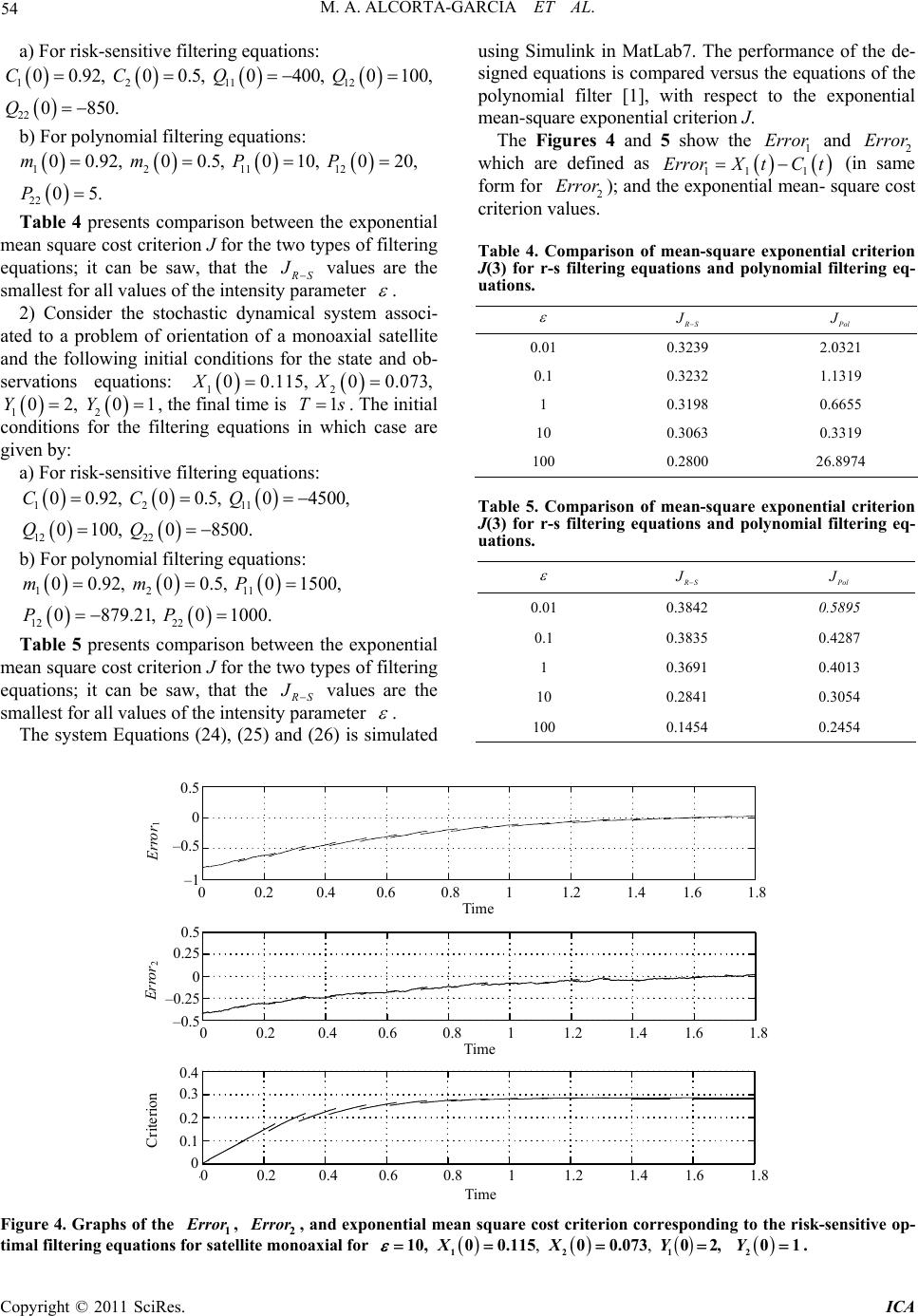 M. A. ALCORTA-GARCIA ET AL. Copyright © 2011 SciRes. ICA 54 a) For risk-sensitive filtering equations: 12 1112 22 00.92, 00.5, 0400, 0100, 0 850. CCQQ Q b) For polynomial filtering equations: 121112 22 00.92, 00.5, 010, 020, 05. mmPP P Table 4 presents comparison between the exponential mean square cost criterion J for the two types of filtering equations; it can be saw, that the R S J values are the smallest for all values of the intensity parameter . 2) Consider the stochastic dynamical system associ- ated to a problem of orientation of a monoaxial satellite and the following initial conditions for the state and ob- servations equations: 12 00.115, 00.073,XX 12 02, 01YY, the final time is 1Ts. The initial conditions for the filtering equations in which case are given by: a) For risk-sensitive filtering equations: 1211 12 22 00.92, 00.5, 04500, 0100, 08500. CCQ QQ b) For polynomial filtering equations: 1211 12 22 00.92, 00.5, 01500, 0879.21, 01000. mmP PP Table 5 presents comparison between the exponential mean square cost criterion J for the two types of filtering equations; it can be saw, that the R S J values are the smallest for all values of the intensity parameter . The system Equations (24), (25) and (26) is simulated using Simulink in MatLab7. The performance of the de- signed equations is compared versus the equations of the polynomial filter [1], with respect to the exponential mean-square exponential criterion J. The Figures 4 and 5 show the 1 Error and 2 Error which are defined as 11 1 ErrorXtC t (in same form for 2 Error ); and the exponential mean- square cost criterion values. Table 4. Comparison of mean-square exponential criterion J(3) for r-s filtering equations and polynomial filtering eq- uations. R S J P ol J 0.01 0.3239 2.0321 0.1 0.3232 1.1319 1 0.3198 0.6655 10 0.3063 0.3319 100 0.2800 26.8974 Table 5. Comparison of mean-square exponential criterion J(3) for r-s filtering equations and polynomial filtering eq- uations. R S J P ol J 0.01 0.3842 0.5895 0.1 0.3835 0.4287 1 0.3691 0.4013 10 0.2841 0.3054 100 0.1454 0.2454 Error 1 Erro r 2 Criterion 0 0.2 0.4 0.6 0.8 1 1.2 1.4 1.6 1.8 Time 0.5 0.4 0 0.2 0.4 0.6 0.8 1 1.2 1.4 1.6 1.8 Time 0 0.2 0.4 0.6 0.8 1 1.2 1.4 1.6 1.8 Time 0 – 0.5 – 1 0.5 0.25 0 – 0.25 – 0.5 0.3 0.2 0.1 0 Figure 4. Graphs of the 1 E rror , 2 E rror , and exponential mean square cost criterion corresponding to the risk-sensitive op- timal filtering equations for satellite monoaxial for 10, , 10 0.115X , 20 0.073X 102,Y 201Y. 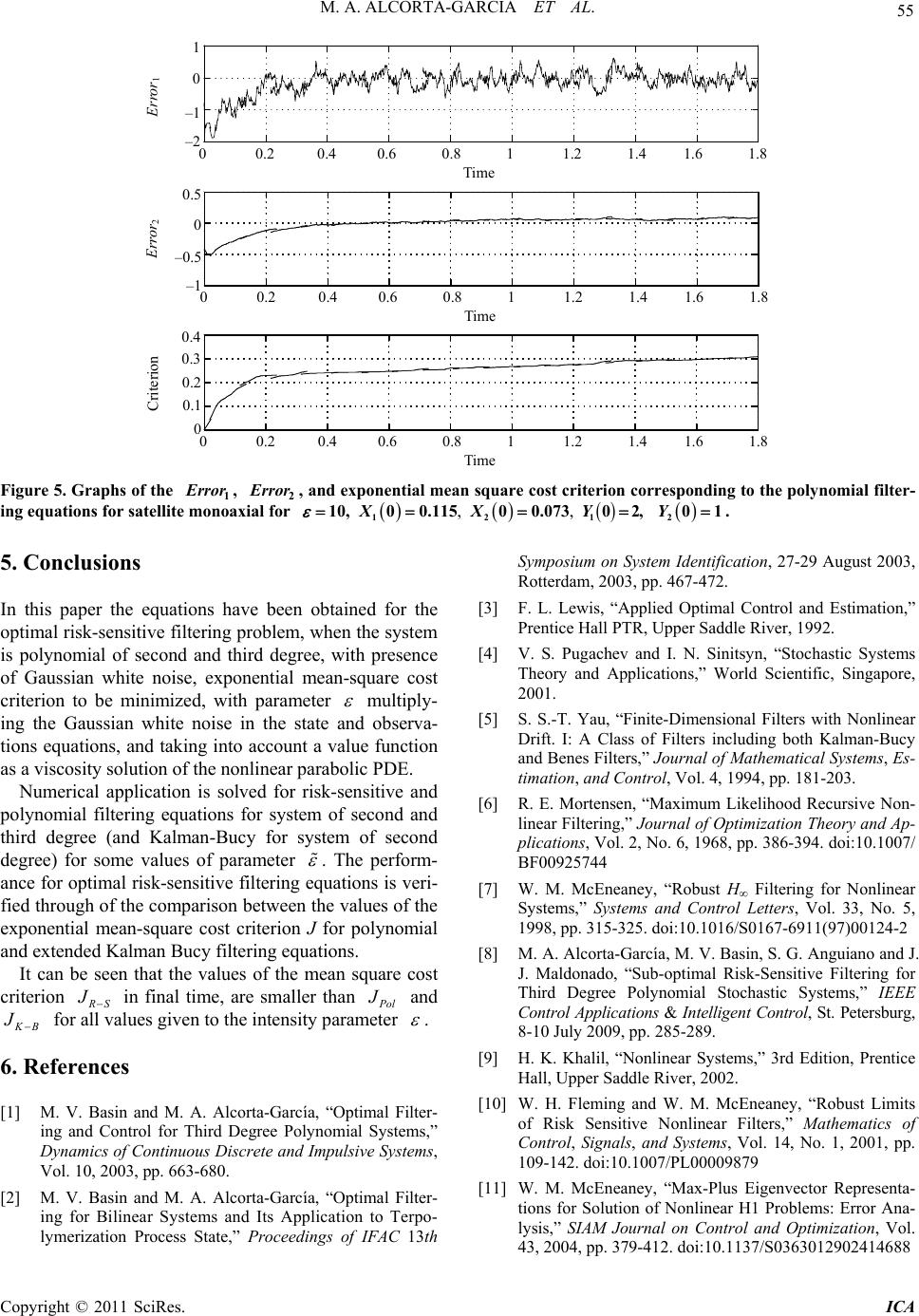 M. A. ALCORTA-GARCIA ET AL. Copyright © 2011 SciRes. ICA 55 Error 1 Erro r 2 Criterion 0.5 0.4 Time 0 – 0.5 0.3 0 0.2 0.4 0.6 0.8 1 1.2 1.4 1.6 1.8 Time 0 0.2 0.4 0.6 0.8 1 1.2 1.4 1.6 1.8 Time – 1 – 1 – 2 0 1 0.2 0.1 0 0 0.2 0.4 0.6 0.8 1 1.2 1.4 1.6 1.8 Figure 5. Graphs of the 1 E rror , 2 E rror , and exponential mean square cost criterion c orresponding to the polynomi al filter- ing equations for satellite monoaxial for 10, , 10 0.115X , 20 0.073X 102,Y 201Y. 5. Conclusions In this paper the equations have been obtained for the optimal risk-sensitive filtering problem, when the system is polynomial of second and third degree, with presence of Gaussian white noise, exponential mean-square cost criterion to be minimized, with parameter multiply- ing the Gaussian white noise in the state and observa- tions equations, and taking into account a value function as a viscosity solution of the nonlinear parabolic PDE. Numerical application is solved for risk-sensitive and polynomial filtering equations for system of second and third degree (and Kalman-Bucy for system of second degree) for some values of parameter . The perform- ance for optimal risk-sensitive filtering equations is veri- fied through of the comparison between the values of the exponential mean-square cost criterion J for polynomial and extended Kalman Bucy filtering equations. It can be seen that the values of the mean square cost criterion R S J in final time, are smaller than P ol J and K B J for all values given to the intensity parameter . 6. References [1] M. V. Basin and M. A. Alcorta-García, “Optimal Filter- ing and Control for Third Degree Polynomial Systems,” Dynamics of Continuous Discrete and Impulsive Systems, Vol. 10, 2003, pp. 663-680. [2] M. V. Basin and M. A. Alcorta-García, “Optimal Filter- ing for Bilinear Systems and Its Application to Terpo- lymerization Process State,” Proceedings of IFAC 13th Symposium on System Identification, 27-29 August 2003, Rotterdam, 2003, pp. 467-472. [3] F. L. Lewis, “Applied Optimal Control and Estimation,” Prentice Hall PTR, Upper Saddle River, 1992. [4] V. S. Pugachev and I. N. Sinitsyn, “Stochastic Systems Theory and Applications,” World Scientific, Singapore, 2001. [5] S. S.-T. Yau, “Finite-Dimensional Filters with Nonlinear Drift. I: A Class of Filters including both Kalman-Bucy and Benes Filters,” Journal of Mathematical Systems, Es- timation, and Control, Vol. 4, 1994, pp. 181-203. [6] R. E. Mortensen, “Maximum Likelihood Recursive Non- linear Filtering,” Journal of Optimization Theory and Ap- plications, Vol. 2, No. 6, 1968, pp. 386-394. doi:10.1007/ BF00925744 [7] W. M. McEneaney, “Robust H∞ Filtering for Nonlinear Systems,” Systems and Control Letters, Vol. 33, No. 5, 1998, pp. 315-325. doi:10.1016/S0167-6911(97)00124-2 [8] M. A. Alcorta-García, M. V. Basin, S. G. Anguiano and J. J. Maldonado, “Sub-optimal Risk-Sensitive Filtering for Third Degree Polynomial Stochastic Systems,” IEEE Control Applications & Intelligent Control, St. Petersburg, 8-10 July 2009, pp. 285-289. [9] H. K. Khalil, “Nonlinear Systems,” 3rd Edition, Prentice Hall, Upper Saddle River, 2002. [10] W. H. Fleming and W. M. McEneaney, “Robust Limits of Risk Sensitive Nonlinear Filters,” Mathematics of Control, Signals, and Systems, Vol. 14, No. 1, 2001, pp. 109-142. doi:10.1007/PL00009879 [11] W. M. McEneaney, “Max-Plus Eigenvector Representa- tions for Solution of Nonlinear H1 Problems: Error Ana- lysis,” SIAM Journal on Control and Optimization, Vol. 43, 2004, pp. 379-412. doi:10.1137/S0363012902414688 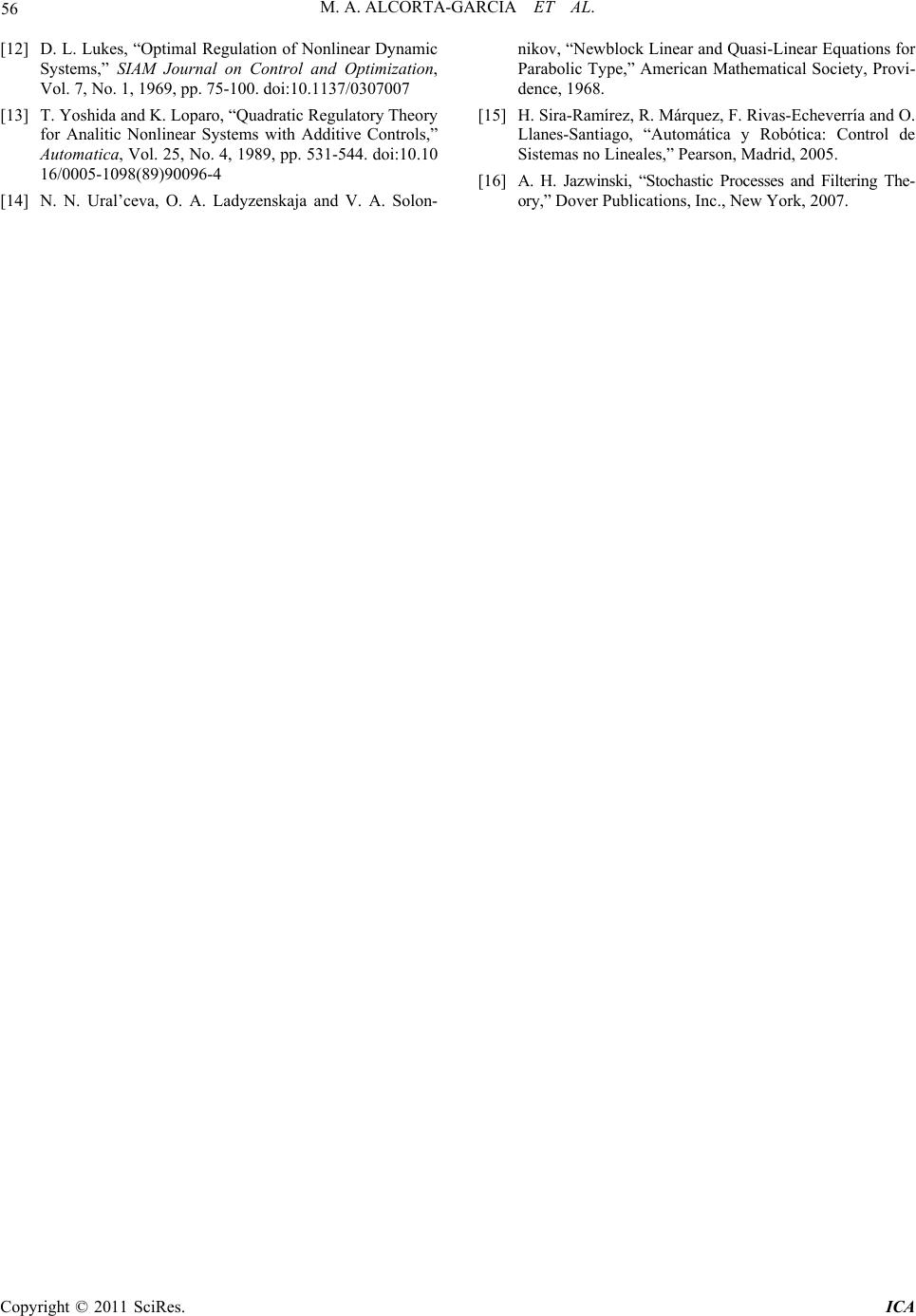 M. A. ALCORTA-GARCIA ET AL. Copyright © 2011 SciRes. ICA 56 [12] D. L. Lukes, “Optimal Regulation of Nonlinear Dynamic Systems,” SIAM Journal on Control and Optimization, Vol. 7, No. 1, 1969, pp. 75-100. doi:10.1137/0307007 [13] T. Yoshida and K. Loparo, “Quadratic Regulatory Theory for Analitic Nonlinear Systems with Additive Controls,” Automatica, Vol. 25, No. 4, 1989, pp. 531-544. doi:10.10 16/0005-1098(89)90096-4 [14] N. N. Ural’ceva, O. A. Ladyzenskaja and V. A. Solon- nikov, “Newblock Linear and Quasi-Linear Equations for Parabolic Type,” American Mathematical Society, Provi- dence, 1968. [15] H. Sira-Ramírez, R. Márquez, F. Rivas-Echeverría and O. Llanes-Santiago, “Automática y Robótica: Control de Sistemas no Lineales,” Pearson, Madrid, 2005. [16] A. H. Jazwinski, “Stochastic Processes and Filtering The- ory,” Dover Publications, Inc., New York, 2007. |

